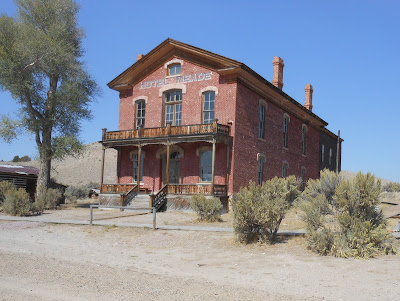It was another warm sunny September day as we
cruised from Missoula to Dillon. The speed
limit is 75 mph on most Montana freeways, but there was very little traffic so we were able to cruise
along at our usual fuel efficient speed of about 60 mph, enjoying every scenic detail along the way.
Dillon: During the winter of 1880-81, a railroad town called Terminus was built as
an instant “end-of-track” town. The Utah
and Northern Railroad was being built to Butte and this was the end of one
segment. Streets were laid out and
buildings erected almost instantly. The
railroad was eventually extended, it later became the Union Pacific, and the town’s
name was changed to Dillon. The
community grew to become a business and ranching center, as well as the county seat of
Beaverhead County and home of Western Montana College.
Our primary interest in stopping at Dillon was to visit some
historic ghost towns in the area.
 Bannack
was founded in 1862 when gold was discovered on Grasshopper Creek in
a remote canyon 25 miles west of Dillon. The town is celebrating its 150th
anniversary this year (2012). As news of
the gold strike spread, thousands of prospectors and businessmen rushed to Bannack
hoping to strike it rich. The town was
built quickly and, in 1864, Bannack was named the first Territorial Capital of
Montana. Bannack also had the first
hotel in Montana, the first jail, the first school, the first chartered masonic
lodge, the first commercial sawmill, etc.
Bannack
was founded in 1862 when gold was discovered on Grasshopper Creek in
a remote canyon 25 miles west of Dillon. The town is celebrating its 150th
anniversary this year (2012). As news of
the gold strike spread, thousands of prospectors and businessmen rushed to Bannack
hoping to strike it rich. The town was
built quickly and, in 1864, Bannack was named the first Territorial Capital of
Montana. Bannack also had the first
hotel in Montana, the first jail, the first school, the first chartered masonic
lodge, the first commercial sawmill, etc.
Shortly after the Bannack gold rush, another major gold strike
took place on Alder Creek, about 70 miles east.
Many of the miners left Bannack in hopes of finding the mother lode in the
new towns of Nevada City and Virginia City.
Along with the miners went the Capital, which was a major disappointment.
 |
| Bannack, Montana |
The building beyond the old International truck was built in 1875 as the Beaverhead County Courthouse. When the railroad arrived in Dillon in 1880, the county seat was moved to Dillon and this building remained vacant for about ten years.
In 1891, the old courthouse was turned into the plush Hotel Meade and became the social center of Bannack until the 1940s.
 |
| Interior of one of Bannack's un-restored buildings. |
Most buildings are just as they were when the town was acquired by the state in 1954. Old wallpaper, linoleum, plumbing fixtures and sometimes appliances are frozen in time. Others, such as the bachelor cabins below, couldn't meet the test of time.
 |
| Hiking up the hill to the original Bannack Cemetery (inside fence) |
From the late 1860's to the 1930's, Bannack continued as a mining town. However, its population continued to dwindle. By 1954, most of the gold had been found and most folks had moved on. At that point the State of Montana acquired the town site and declared Bannack a State Park.
Another unique characteristic of Bannack is the lack of commercialism. There are no T-shirt shops, coffee kiosks, souvenir stores, etc., and nobody lives there anymore. Walking down its lonely streets gave us a sense of what it was like 150 years ago in a Montana gold rush town. Now it’s a real ghost town . . . and there are stories of real ghosts, although we didn’t encounter any.
Virginia City is a National Historic Landmark and considered one of Montana’s premier ghost towns. But, unlike Bannack, it’s also a living community with residents and operating businesses. It’s considered one of America’s finest collections of old west artifacts and 1860s “boom town” buildings on their original sites. Most of the old buildings front on Wallace Street (Hwy. 287), while others are scattered around the hilly town.
 |
| Original storefronts along Wallace Street |
 |
| Hangman's Building - 5 "road agents" were hung in this building in 1864. |
The original Boot Hill Cemetery was used for only a few years. When the five “road agents” were hung and
buried there, most other graves were moved to a new cemetery in 1868. The road agents’ markers are all that remain
at the original site.
When miners were seeking their fortunes, they turned Alder Creek
upside down. Rock and gravel debris
piles and tailings can still be seen everywhere along the creek. It’s a mess!
Today, miners are still working along the creek but not so much for
gold. Now they’re mining garnets and
other stones for use in saw blades, sandpaper and other industrial uses.
 |
| Mining debris and tailings along Alder Creek |
When we returned to Dillon from Virginia City, the smoke from the
Idaho and other fires was worse than ever and our eyes were burning. Mountains surround the Beaverhead Valley, but
we couldn’t see them most of the time.
We had a good time visiting the ghost towns, but it was time to move on
down the road in search of cleaner air.
 |
| Smoky sunset in Dillon |









No comments:
Post a Comment